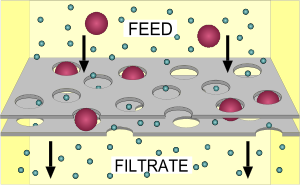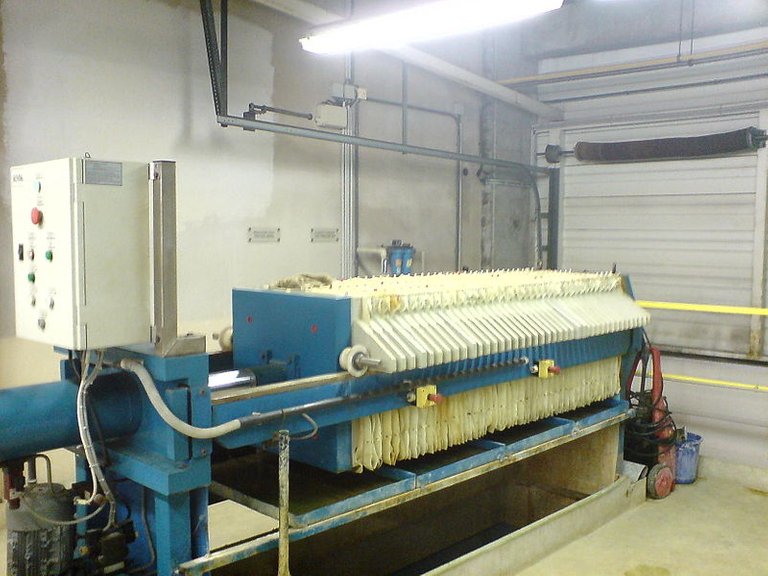Filtration Equipment, Part 1

Filtration
Filtration is an important process in the industrial world of chemical engineering. It produces high purity goods which satisfy our needs for food, water as well as provides a factor of security of our health. In this post, and the next, I will be going through the different forms of equipment as well as product evaluation methods that occur in order to produce these products.
Due to filtration being able to take place over a variety of different ways it was easier for engineers to group together certain filtration operations to assist in the classification of filters.
The classifications are mainly based upon the equipment used for that specific form of filtration. The equipment used are based upon the following factors:
- Operating Cycle
- Product type desired
- Arrangement of the of filter media (mechanical)
- The driving force of the filtration cycle
The most important point of classification is the form of driving force used during filtration. As mentioned in my previous posts, there are many forms of driving forces that would facilitate filtration but the main focus point of this post are gravity, vacuum, pressure and centrifugal forces (due to these forces being used most in industry).
Gravity Filter:

Gravity Filters (sand filter)
A gravity filter is considered the simplest form of filters and has zero direct running costs. The disadvantage however is that this equipment occupies a large surface area and volume, therefore, it takes up a lot of space in the room. The other disadvantage of gravity filters is that the solid particles will still contain an unfavourable amount of liquid within or around the surface of the solid after separation. Due to this encapsulation of water within the solid, unfavourable factors such as additional capital and cost will have to be added into budget to accommodate for further refining.
Gravity filters are not independent equipment and does depend upon atmospheric pressure to persuade the solids through the filter medium. Slurry enters through the top of the filter and makes it’s way through the filter medium. It can be noted that a clear filtrate emerges from the under drain of the filter medium.
Travelling bed filters, rotary drum gravity filters as well as sand filters are examples of filters that manipulate and facilitate the Gravity driving force.
Vacuum Filter:
As identifiable by the name, a vacuum filter requires a vacuum in order to successfully complete filtration through a medium. A vacuum can be easily conjured by suctioning by an ordinary liquid pump or by a device of gas displacement (such as that of a steam ejector or rotary vacuum pump).
Dependent open device specifications, the effect of the driving force should be around 12 psi or 0.81 bar. At this force it is sufficient for filtration to produce favourable rates and a good, pure desirable product.
The vacuum is often created behind the filtration medium while atmospheric pressure acts upon the front of the filtration medium. The pressure difference (pressure drop), as explained in my previous posts, causes the slurry to filter through the medium and thus filters out the suspended solids in the filtration process.
Belt filters, horizontal pan filters, vertical disc filters and a variety of drum filters are all examples of vacuum filters.
Pressure Filters:
Pressure filters are often the most used filters due to it producing a greater output per unit area of slurry. Therefore produces a larger volume of cake as well as filtrate, in a smaller period of time.
Pressure filters operate on a similar principle as the vacuum filter except that in this case the feed slurry is under a large pressure before being introduced to the system and is therefore forced through the filter medium due to the pressure drop across the medium.
The most basic and effective design of a pressure filter is a plate type filter press, which will be discussed later on in great detail.
Centrifugal Filters:
In industry, it is understood that centrifugal filters have the most simple and compact construction of all filter types and also has the lowest running cost. However, there is a downfall to this form of filtering. A centrifugal filter can only satisfactorily filter particles of above 10 micrometres. When particles of below 10 micrometres are introduced to the system, solids are discharged as a slurry mixture.
It is possible to achieve high throughputs, relative to the size of the filter used. For this to occur however, a piece of equipment of high capital cost is required.
Cake Washing:
Before venturing further into the intricacy of plate filters, we must understand what happens once the cake is produced. When a cake is produced by filtration process, it still (to some degree) has moisture within the cake. Since water is regarded as an impurity within the cake, engineers devised a process to further reduce the amount of moisture present in the cake particles. This process is referred to as Cake Washing.
Cake washing is essentially the removal of any last traces of liquid within the solids of the cake. The added reasons as to why cake was occurs is due to:
- Chemically unwanted or unacceptable products within the product solid is removed.
- Added purity of the cake therefore making it a more valuable product with a higher monetary value.
- Cake washing facilitates cleaning of solids before it is disposed of, thus, provides an environmental advantage.
Cake washing can occur via three main method (i.e.) washing by:
- Displacement in cakes
- Reslurring of the filter cakes
- Dilution
The major advantage of these methods of cake washing is the fact that these processes can be carried out individually or by means of a combination process. This means that the method can occur over a single stage or multistage platform and can run concurrently or counter currently to any other process. This is an advantage due to the fact that capital can be saved on cost as the process time is shortened by this combination.
A major factor that is taken into consideration during the process of cake washing is how much of liquid wash is needed for optimisation of the process. The amount of wash liquid required is dependent upon the desired reduction of the overall liquid in the cake as well as the wash ratio that can be read off a wash curve, which shall be discussed next. Taking these factors into consideration and multiplying this to the void volume in the cake will give us the volume of liquid wash required.
Through experiments conducted over years of research, an equation was derived, by the scientific group of Choudhury and Dahlstrom, which states:

Whereby,
R(n) = fraction of solute remaining (C/Co)
E = efficiency of washing the cake
n = washing ratio = (volume of liquid wash)/(volume of solution in cake)
It can be noted that for fast washing cakes, the general value of n is often 2,1.
The washing ratio is often read of a chart known as the washing curve, which facilitates in the identification of the ratio. The initial figure (Figure 1) is used to illustrate how the filtrate concentration within the wash solvent (that leaves the cake) varies with volume of wash solvent passed along it. The second figure (Figure 2) is used to form a comparison between the washing curves of a cake that is saturated as well as a cake that is dewatered. This figure will give us an indication as to whether the cake should be dewatered or not before washing.

Figure 1

Figure 2
This brings us to the end of part 1 of the filtration equipments used in industry and gives us an insight into the intricacy as well as the simplicity of these instruments. In my next post I will be introducing the filter press as well as the different branches or types of Filter presses as well as Filter Media.
Images are linked to their sources in their description
The End
References:
[1]https://www.lenntech.com/chemistry/filtration.htm
[2]https://www.filter-concept.com/industrial/types-of-filtration/
[3]Unit Operations of Chemical Engineering by McCabe W.L., Smit J.C. and Harriot P (McGrawHill, 7th Edition, 2005)
[4]https://www.envites.cz/en/products/filter_presses/with.../filtration_with_cake_washing/
[5]Coulson and Richardson's Chemical Engineering. Vol. 2, Oxford, ButterworthHeinemann by RICHARDSON, J. F., HARKER, J. H., BACKHURST, J. R., & COULSON, J. M. (2002).

Being A SteemStem Member